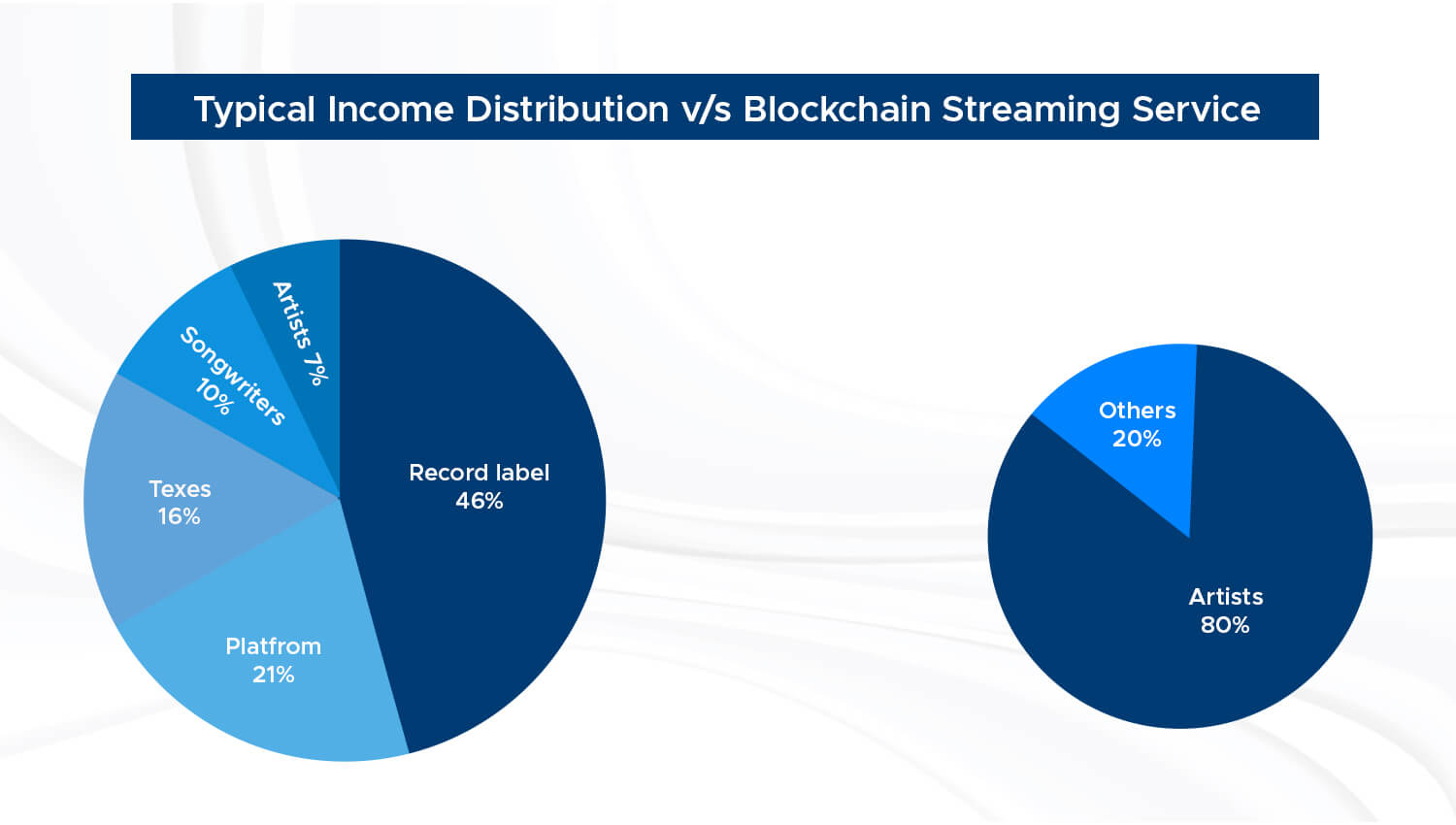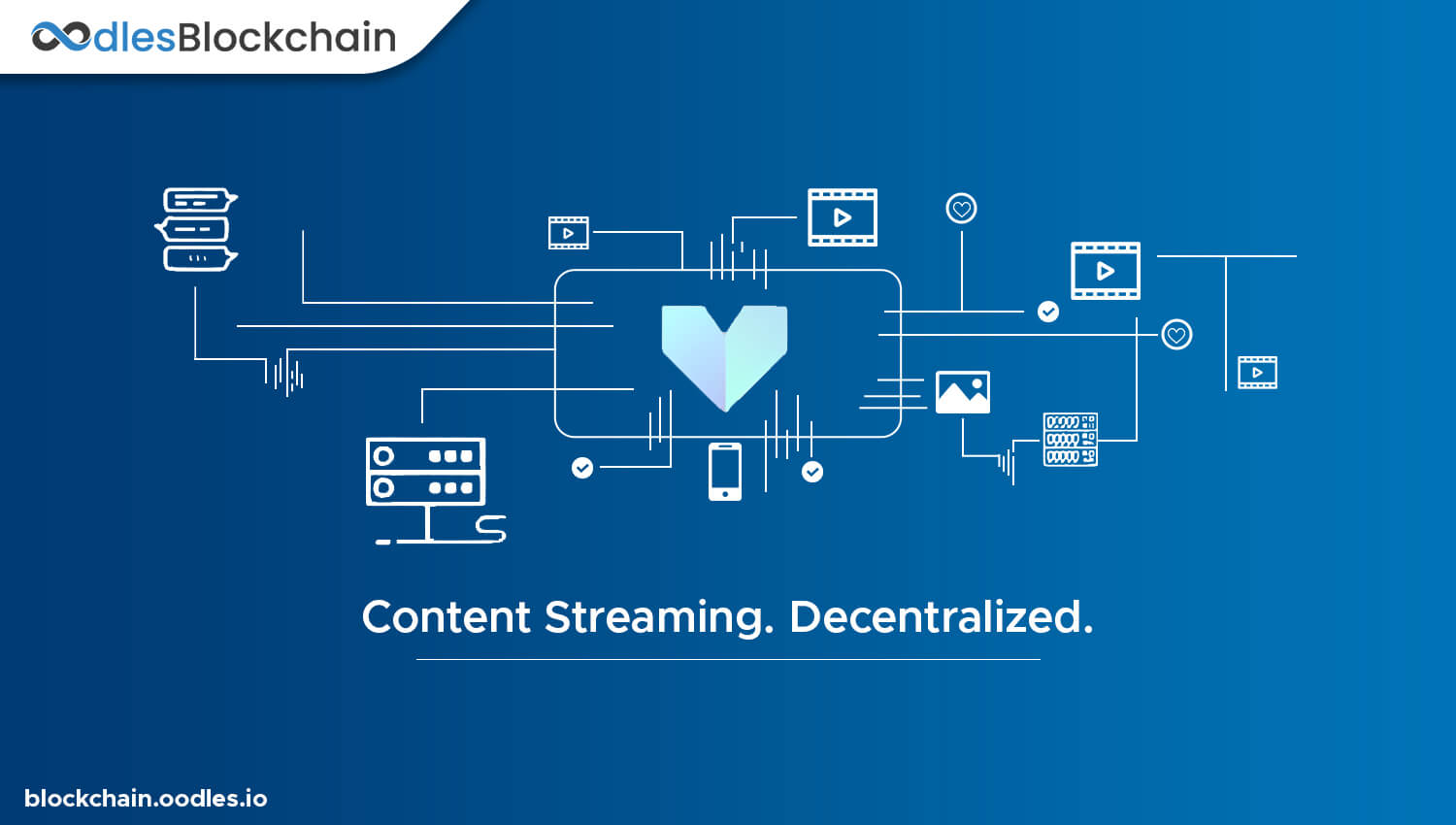-
Post the pandemic, streaming platforms have seen a significant acceleration in growth, whether it is audio, video, or live streaming. While everything appears in order on the surface, let us take a look behind the curtain. For instance, video streaming is extremely expensive. Therefore, startups and companies face million-dollar bills for providing streaming services. Video streaming is costly mainly because of the transcoding process. It is a process that reformats raw video clips and makes them compatible with various devices and bandwidths. If we consider the budgeting of the process, transcoding charges hover around $3 to $4 stream per hour on an Amazon-like cloud service. It can cost up to $4500/ month for one media server. Read on to find out if blockchain streaming development can address the challenges. It results in exorbitantly high infrastructure costs. Subsequently, startups and broadcasters fail to bear such c charges. They either fail to sustain their operations or levy heavy charges on their offerings or run them with advertisements. An end user eventually pays these charges or is forced to watch irrelevant ads. It is only the surface of the challenges in the streaming industry we have scratched. There are other numerous issues plaguing the industry.
Can Decentralized Solutions by Blockchain Prove Efficient?
Now, is it conceivable to have a scalable and economical streaming solution given the exponential rise in demand for streaming services? In this situation, thanks to peer-to-peer, blockchain-based streaming solutions, the industry can transform. A streaming network built on the blockchain can help with several industry issues. In addition to cutting expenses, it can open up options for consumers and content creators to make money. Let's delve more into the notion of blockchain-based streaming. Decentralized streaming platforms are usually community-owned. Blockchain facilitates ownership within the ecosystem. It also lays the foundation for decentralization. As a result, it provides a perfect base layer for applications. Also, Read | Why Develop Live Streaming Solutions with Blockchain
Decentralized Streaming
 When a single company is not controlling or managing the content delivery for a streaming service, we consider it as decentralized. It's crucial to understand the distinction between distributed and decentralized streaming. Decentralization completely removes such control while distributed streaming means that a single organization remains in charge of the content delivery network. Establishing a network where users can agree on the network's course of action, adds another level of democracy and gives the community additional power. Also, Read | Decentralized Live Streaming Solutions with Blockchain Platforms for decentralized streaming are typically community-owned. Blockchains provide the ideal foundation for apps by enabling ownership within the platform and serving as the basis for decentralization. Blockchain connects all the components through a single decentralized ledger. All off-chain transactions must provide proof to the blockchain layer, which then confirms the transaction's legitimacy. As a result, the blockchain becomes the only reliable source of information. Still, off-chain methods like IPFS or peer-to-peer storage make the data accessible because blockchains cannot store complicated data sources like films or photographs. Also, Read | Developing a Blockchain-Powered Media Streaming Platform
When a single company is not controlling or managing the content delivery for a streaming service, we consider it as decentralized. It's crucial to understand the distinction between distributed and decentralized streaming. Decentralization completely removes such control while distributed streaming means that a single organization remains in charge of the content delivery network. Establishing a network where users can agree on the network's course of action, adds another level of democracy and gives the community additional power. Also, Read | Decentralized Live Streaming Solutions with Blockchain Platforms for decentralized streaming are typically community-owned. Blockchains provide the ideal foundation for apps by enabling ownership within the platform and serving as the basis for decentralization. Blockchain connects all the components through a single decentralized ledger. All off-chain transactions must provide proof to the blockchain layer, which then confirms the transaction's legitimacy. As a result, the blockchain becomes the only reliable source of information. Still, off-chain methods like IPFS or peer-to-peer storage make the data accessible because blockchains cannot store complicated data sources like films or photographs. Also, Read | Developing a Blockchain-Powered Media Streaming PlatformAdvantages of Decentralized Streaming
Peer-to-peer networks enabled by blockchain technology operate without a centralized authority. P2P networks offer features that operate by dispersing the media material rather than concentrating on a single server. The decentralized nature of blockchain benefits curators of video content since they may post and transmit video material directly to their audience without the need for a central server or middleman. Because blockchain uses a P2P framework, video streaming is significantly better when done on a decentralized network. A P2P network increases the likelihood that one stream will divide and become dispersed. It occurs as a result of P2P's higher replication rate for streaming than the client-server CDN arrangement does. Both creators and audiences can join the blockchain network without the need for a middle controller. The network is used by the content curators to independently broadcast their content, which the public can view once other nodes have approved it. Also, Read | Insights into Video Streaming Platform Development with Blockchain Blockchain-based video streaming enables content creators to gain direct access to the revenue produced by the blockchain network. The audience only pays for the streaming service they find most interesting. Therefore, it helps content curators to offer videos based on audience demand. The blockchain can be used by content producers to safely encrypt their video storage. Blockchain enables content curators to receive payments from users in the form of cryptocurrency tokens. When viewers pay membership fees to their preferred streams, curators and creators receive payment accordingly. Additionally, if viewers choose to rent their extra disc space and network bandwidth to store and broadcast the movies, they can also profit handsomely from doing so.
Benefits of Blockchain-based Streaming
The following are the different ways that the blockchain supports and reinvents internet video streaming:
Smart Contracts
Blockchain smart contracts provide direct communication to create an independent relationship between a creator and an audience. It prevents third parties from interfering with revenue generation. It does away with the expense of a middleman and automatically monitors license security.
Blockchain-powered CDN
Content producers publish terabytes of content on internet platforms every day, thus, storage space optimization is crucial for them. As a result, a blockchain-based content delivery network also is crucial. It enables users all over the world to use the aggregate optimum storage space. The content producers might utilize the collectively available, space by transforming it into a P2P cloud storage and data distribution system with the aid of a blockchain-based management system. Also, Read | The Emergence of Decentralized Blockchain Video Streaming Solutions
Accessibility and Ownership
The security of ownership and access to producers' content is one of the most frequently occurring problems in online media and the OTT sector. For instance, in a centralized video streaming site, only one user can access the videos because only that person is paying to utilize the platform. Contrary to purchasing a DVC or CD in which you own the tape, this lacks transparency. Blockchain can solve the problem of ownership at a protocol level. Blockchain enables IPFS swarm to assist authors and viewers encrypt and permanently saving their videos. With the aid of numerous relay nodes and IPFS, Blockchain autonomously transmits the video material while upholding ownership integrity and transparency in a decentralized manner. In the form of NFTs, blockchain also preserves ownership of video streamers. Individuals that broadcast their video content can also sell it on the marketplaces for cryptocurrencies. By tokenizing their content on the network, they also protect the ownership of their video content.
Micropayments and Quick Transactions
Blockchain enables online micropayments for users and content creators without any transaction costs or service fees. By using a blockchain-enabled browser, the user can use a crypto wallet to monetize their monthly expenditure. The browser can then use content IDs to inspect the uploaded media and retrieve license data from the public blockchain. To facilitate the transaction between the user and the content owner, it leverages on-chain payment. Also, Read | Exploring Blockchain-based Online Video Streaming Solutions
Decentralized Content Distribution
Any participant can access their transaction histories directly on the blockchain without the use of intermediaries. The blockchain also eliminates the need for any central authority to authorize transactions through the peer-to-peer network, enabling more flexible and frictionless trades.
Licencing and Efficient Monetization of Content
 Creators of virtual content know the legal ramifications of intellectual property laws as well as how easily anyone can plagiarise or reproduce their work. If their intellectual property is used for profit, they have the right to ownership recompense. The producers of the content are solely responsible for upholding intellectual property rights when working with a larger organization. The use of blockchain technology can greatly simplify copyright management. With blockchain, content creators can have greater control over ownership of their creations. Also, Read | How NFTs are Revolutionising the Music Industry
Creators of virtual content know the legal ramifications of intellectual property laws as well as how easily anyone can plagiarise or reproduce their work. If their intellectual property is used for profit, they have the right to ownership recompense. The producers of the content are solely responsible for upholding intellectual property rights when working with a larger organization. The use of blockchain technology can greatly simplify copyright management. With blockchain, content creators can have greater control over ownership of their creations. Also, Read | How NFTs are Revolutionising the Music IndustrySome examples
Let's look at a few companies that are already revolutionizing the fields of streaming, blockchain, and cryptocurrency. BitTorrent has recently introduced a blockchain for live-streaming events. It is becoming popular for tokenizing file sharing. Audius is using a blockchain-based network intended to assist independent musicians to get into the mainstream, but facing accusations of hosting a significant volume of pirated content, similar to previous firms like earlier iterations of Napster. Last but not least, VideoCoin uses a blockchain-based platform to enable makers, entertainers, and artists to share content at cheaper costs than might otherwise be possible. The dual expansion of blockchain and streaming services is a significant component of the internet's future.
Conclusion
Technologies like blockchain and crypto are fuelling the development of streaming services and businesses generally. Both make it possible for people and organizations to collaborate, communicate, and engage with one another globally. Taking the next step in content creation and payment could be the ideal chance for blockchain, cryptocurrency, and streaming to develop altogether. Do you have any idea in mind for a streaming application? Get help from our skilled blockchain developers for developing a dynamic and user-friendly application for streaming content.

Our Offices
INDIA
Emaar Digital Greens, Sector 61,
Gurugram, Haryana
122011.
Welldone Tech Park,
Sector 48, Sohna road,
Gurugram, Haryana
122018.














